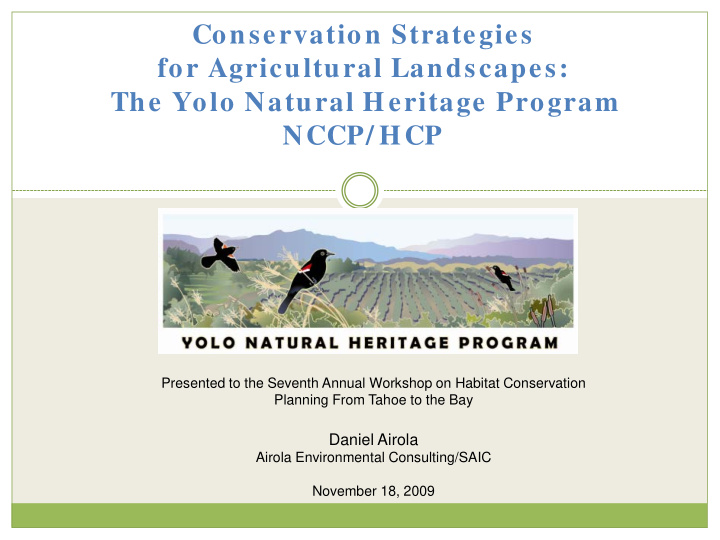



Conservation Strategies for Agricultural Landscapes: The Yolo Natural Heritage Program NCCP/ HCP Presented to the Seventh Annual Workshop on Habitat Conservation Planning From Tahoe to the Bay Daniel Airola Airola Environmental Consulting/SAIC November 18, 2009
Yolo Natural Heritage Program - Key Elem ents County-wide HCP/ NCCP 654,000 acres 50 year permit Goals • Conserve natural heritage • Support viability of the agricultural economy • Promote smart, sensible economic growth • Protect natural areas and features • Preserve open space areas and enhance recreation A Conservation Plan, not just a mitigation plan
Yolo NHP Covered Activities Wide range of Covered Activities addressed Development under General Plans only 3-5% of land area Utilities, transportation, flood control, water supply, parks new facilities operations and maintenance Agriculture ongoing activities limited conversion of natural habitats
Yolo County Agriculture The County’s primary economic activity Cultivated agric = 360,000 ac 56% of total land area Highly diverse mix of agricultural crops Farmlands provide important habitat value 21 of 65 covered species Engaging farmers is critical to the conservation strategy
Value of Crops to Covered Wildlife 30 25 20 15 10 5 0 Natural Pasture Rice Grain and Alfalfa Seed Crops Orchard/ Truck Habitat Hay Vineyard crops
HCP Coverage Needs for Agriculture • Incidental mortality and injury to species • Habitat change • Marketing benefit of conservation (“Certified”)
Yolo Agricultural Landscape is Dynam ic Shorter term changes Annual condition changes - prepping, cultivating, growing, harvesting Crop rotations among years Water availability Potential longer term changes: Crop economics Water sales Development Climate change
Process for Incorporating Agricultural Species Conservation into the NHP Describe agricultural habitats Describe species relationships to habitats Identify habitat goals for species Evaluate contributions to goals provided by agriculture Integrate agricultural lands with natural communities
Agricultural Crop Groups Crop Type Acres Percent FIELD CROPS 99,284 27% GRAIN AND HAY CROP 74,139 20% TRUCK & BERRY CROPS 64,370 18% PASTURE 41,863 11% RICE 30,411 8% DECIDUOUS FRUITS AND NUTS 25,756 7% IDLE 15,862 4% VINEYARD 9,438 3% SEMIAGRICULTURAL & INCIDENTAL TO AGRICULTURE 3,339 1% CITRUS AND SUBTROPICAL 303 0% Total Acres of Agriculture 364,765 100% Total Acres in County 653,629
Yolo Agriculture Crops Field Crops Pasture Vineyard Cotton Alfalfa and alfalfa mixtures Safflower Clover Citrus and Subtropical Sugar beets Mixed pasture Oranges Corn (field and sweet) Native pasture Olives Grain sorghum Miscellaneous grasses (grown for Kiwi Sudan seed) Eucalyptus Beans (dry) Turf farms Sunflowers Idle Grain and Hay Truck and Berry Crops Sem i-Agriculture Asparagus Rice Farmsteads Beans (green) Livestock Feed Lots Cole crops Deciduous Fruits & Nuts Poultry Farms Carrots Apples Melons, squash, and cucumbers Apricots Onions and garlic Cherries Tomatoes Peaches and nectarines Flowers, nursery, Christmas tree Pears farms Prunes Mixed (four or more) Figs Miscellaneous Miscellaneous Bush berries Almonds Strawberries Walnuts Peppers Pistachios Broccoli Cabbage
Rating Species Use of Crops: Habitat Suitability Model Approach Review scientific literature Input from knowledgeable species biologists Model development Identify Covered Species that use agricultural lands Develop list of crops used by each species Identify relative value of each crop - for different uses (foraging, breeding, resting, dispersal) Key distance variables: to nesting habitat, water, etc Prepare matrix of species-crop habitat values Summarized in Species Accounts and Species Models
Yolo NHP Covered Agricultural Species Giant garter snake Burrowing owl Western pond turtle Long-eared owl White-tailed kite Short-eared owl Bald eagle Yellow-billed magpie Northern harrier Loggerhead shrike Swainson’s hawk Yellow-headed blackbird Golden eagle Tricolored blackbird Peregrine falcon Western red Bat Prairie falcon Townsend’s western big-eared bat Mountain plover Pallid bat Black tern
Assign Habitat Values for Species Use of Each Agricultural Crop Per-acre habitat suitability ratings of crops Very High 1.0 High 0.75 Moderate 0.5 Low 0.25 Very low 0.1 None 0.0
Species-Crop Habitat Matrix
Determ ine Habitat Values of Each Agricultural Type Calculate Ha bita t Units for Species Habitat Units = [crop habitat suitability value] x [# acres of crop] Creates a “common currency” for assessing the value of different combinations of crops
Determ ine Overall Habitat Value Example: Long-billed Curlew Ag Habitat Type Value Acres Habitat Units Pasture Alfalfa and alfalfa mixtures 0.75 * 33,549 = 25,162 Clover 0.5 * 61 = 31 Mixed pasture 0.5 * 4,037 = 2,019 Native pasture 0.75 * 2,371 = 1,778 Misc. grasses (grown for seed) 0.5 * 1,337 = 669 Turf farms 0.5 * 325 = 163 Grain and Hay 0.75 * 74,139 = 55,604 Rice 0.75 * 30,411 = 22,808 0 All other Ag Types 0 * 218,534 = 10 8 ,233 TOTAL HABITAT UNITS
Use of Agricultural Habitat Valuations Describe existing values of agricultural lands Evaluate future scenarios - changes in agricultural use Incorporate with habitat values for other land cover types used by covered species (uplands, riparian, developed) Assess goals achievement in Conservation Strategies and adjust Serve as a basis for monitoring plan accomplishments Use plan monitoring to improve habitat valuation models
Recommend
More recommend